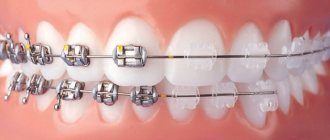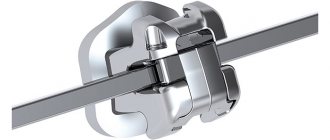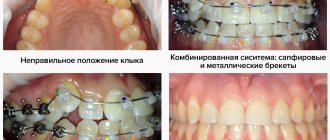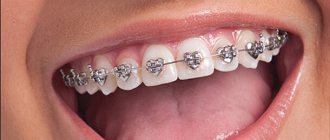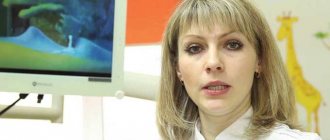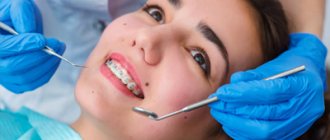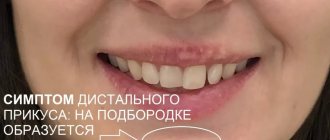In the field of dentistry, new methods for eliminating defects of the lower and upper jaw regularly appear. Each new technology is developed with the goal of speeding up and facilitating the treatment process, while making it comfortable and painless. One of these technologies is self-adjusting or ligature-free braces - systems are an effective alternative to ligature structures. This device instantly gained popularity among both specialists and patients, which was made possible due to its ease of installation and ease of use.
Ligature-free braces are used to quickly correct the curvature of the dentition on both jaws. The main advantage of their use is the short duration of therapy, as well as fairly simple care.
When installed on the enamel surface, special plates equipped with locks are fixed, which are connected by a metal arc. To secure it, the orthodontist will use special movable regulators, which can later be changed and adjusted as the defects are corrected. The fixing elements securely hold the arc, while it has the ability to move. Due to this technology, the dentition does not experience significant pressure.
What are self-ligating braces?
Ligature-free braces consist of an arch and a plate with clasps in which the arch is fixed. As in ligature systems
, self-ligating systems provide for fastening the plate to the tooth surface, but it is more compact - it occupies less area of the crown. One of the main features of non-ligature systems is that the arch is not firmly fixed - it remains mobile within the space inside the lock. Therefore, it can move following changes in the position of the teeth and exerts constant and gentler pressure. The friction force with this treatment is less. In addition, unlike rubber ligatures, the clasps of self-ligating systems do not lose their properties over time.
These differences provide greater comfort for the patient - these braces are easier to wear and easier to care for. In this case, you need to visit the orthodontist less often. If replacing ligatures and correcting the arch when wearing ligature braces requires a visit every 3-4 weeks, then when treating with a self-ligating system, visits are usually scheduled once every 6-8 weeks.
How to care for braces?
Regardless of the type of braces used, ligature or non-ligature, they require careful care. It should be noted that you cannot limit yourself to brushing your teeth in the morning and evening. Due to the fact that braces have protrusions and different methods of fastening, cleaning out food debris becomes problematic.
According to the doctor's recommendations, you will need to purchase a special dental solution, a large brush, a small brush and dental floss from the pharmacy. Oral hygiene will have to be done after every meal. First of all, you need to use a large brush that will remove large food debris from the tooth surface. Then you can move on to a fine brush. Using such a hygienic tool, you can remove germs in hard-to-reach places. The final stage is using dental floss. Only after such manipulations can oral hygiene be completed. One procedure takes on average 10-15 minutes after each meal. On average, it will take 30-40 minutes a day to clean your braces and mouth from bacteria.
Please note: braces can only be installed on completely healthy teeth. If treatment is required for periodontitis or other diseases of the teeth and gums, these problems are first eliminated, and only then the system is installed.
Sincerely, Levin D.V., chief physician
Differences between ligature and non-ligature braces
Non-ligature and ligature braces are designs that are used to correct malocclusion and tooth position. These systems are characterized by different strengths of action, and in each specific case the doctor selects the most appropriate solution.
The difference between ligature and self-ligating braces is the presence and absence of an auxiliary element - a ligature. This largely determines the aesthetics of the system and the speed of obtaining correction results.
There are the following differences between ligature and non-ligature braces:
- Patients report less pain when starting to wear self-ligating systems. The teeth shift slowly, so the discomfort is less than when wearing ligature systems;
- performing hygiene procedures is easier when wearing self-ligating braces. Each meal must be completed by cleansing the oral cavity using special brushes, brushes and an irrigator. More compact sizes and the absence of ligatures make the cleansing process simpler and faster;
- ligature systems help to get results faster - their action is more powerful, they are able to eliminate gross malocclusions;
- aesthetics of non-ligature systems - such braces stand out less against the background of the crown, so the design does not catch the eye. And transparent sapphire braces imitate the shade of your own teeth, add a special shine and look attractive.
After a period of bite correction with both ligature and non-ligature braces, the orthodontist will prescribe the wearing of structures to consolidate the results obtained - the retention period of treatment begins. Wearing retainers and special mouthguards may be required for 1.5-2 years, and in some cases longer, up to constant wear.
One of the most significant advantages for the patient is a relatively shorter appointment with a doctor and a reduction in the number of visits - it is enough to undergo correction once every 6-8 weeks, which is half as often as when using ligature braces.
Non-ligature ceramic systems
Such systems are developed on a ceramic basis: small crystals or granules. The size of the crystals directly affects the strength of the system - the smaller they are, the stronger. However, there is a minor drawback: small granules have lower transparency. Despite the fact that these braces are slightly stronger than metal ones, they look much more aesthetically pleasing. To increase strength, metal components are added to the material for making ceramic models.
Several famous ceramic models:
- Clarity SL. Such models use materials using aluminum oxide. This is the only model whose design uses a minimum amount of metal elements.
- Inovation C. A model that was designed relatively recently. It combines the advantages of a metal analogue of the same name and a wonderful aesthetic appearance. The design consists of a transparent ceramic material with a top layer of silicon oxide. Thanks to this composition, braces look attractive and do an excellent job of their main task - correcting the bite.
- Damon Clear. Braces that are practically invisible on the surface of the teeth. They are made from a special material – sapphire. Another significant advantage is that they do not change color under the influence of dyes.
Materials of self-ligating braces
Ligature-free systems differ in the material of manufacture.
Braces are made from alloys of steel, titanium and artificially grown sapphire. Metal
Metal non-ligature braces are simple, durable and reliable systems. They are applicable for almost any type of malocclusion and can give the desired effect even in difficult cases. Their affordable price makes them the most popular, but it is important to understand that such braces will be visible when you smile.
Ceramic
This type of braces is less durable. They are made from dental ceramics, which can be matched to the shade of your own tooth enamel - this makes the braces less noticeable on the teeth. However, the orthodontic arch will still be visible. Conditional disadvantages include the fragility of the material.
Sapphire
Such braces are also hardly noticeable when smiling and talking. Made from transparent artificial material reminiscent of natural sapphires, they reflect light and give your smile a real shine. Such braces are stronger than ceramic ones and can be used, among other things, for complex malocclusions.
Combined
The disadvantages of sapphire and ceramic non-ligature braces include their price, so modern dentistry offers optimal solutions - a combination of materials. For example, sapphire braces or ceramic elements can be used in the smile area, and metal ones on the chewing teeth. This will help make the treatment cheaper, but still get the desired result in terms of the beauty of your smile.
Advantages of self-ligating braces
Compared to ligature types of braces, self-ligating braces have a higher price, but still remain popular because they have numerous advantages:
- Comfort.
Locks of self-ligating systems are smaller in size, which ensures wearing comfort and a low likelihood of mucosal injuries.
- Aesthetics.
Ligatures visually weigh down the system and make it more significant. Self-ligating braces do not have such disadvantages. In addition, modern aesthetic systems are often ligature-free.
- Addiction.
The small size of the locks and the absence of additional elements ensure a shorter period of adaptation.
How aesthetic are non-ligature braces?
It is believed that ligature-free braces are the most aesthetic type of braces, but this is only partially true. Indeed, sapphire and ceramic braces are chosen for their attractive appearance. Metal ones may look more aesthetically pleasing than ligature ones made of the same material, since the clasps in them are more compact and neat - but it’s difficult to call them aesthetic.
For those who strive to achieve high aesthetics and make orthodontic treatment completely invisible, there is another solution - ligature-free lingual braces. They are fixed on the inside of the teeth, so they are not visible to others at all. It is important to remember that during the first adaptation period they can affect diction, so in cases where professional activity requires perfect pronunciation, it is worth consulting with a dentist and choosing an alternative.
Cost of services
Orthodontics Price
Initial appointment with an orthodontist 700 rubles
Taking an impression from one jaw 600 rubles
Lingual braces (Invisalign (Invisalign) Germany330,000 rubles
Lingual braces (WIN system) Switzerland250,000 rubles
Lingual braces (Pumpa system) 230,000 rubles
Correction of lingual braces with changing arches (installed in the clinic)0 rubles
Correction of lingual braces with changing arches (installed in another clinic) 1 jaw5,000 rubles
Expert of the article you are reading:
Meliksetyan Rita Martikovna
Dentist therapist, orthodontist, pediatric dentist
You may also be interested in:
Insert teeth Installation of filling Implantation “All on four” Express implantation Metal-free crowns Orthodontist consultation Metal-ceramic crown Children’s orthodontist
Show more
The best non-ligature braces
The most popular brands of non-ligation systems are Clarity, Damon, H4, Smartclip.
Damon is one of the most famous brands of ligature-free braces. The line includes systems for different cases - various malocclusions and tooth position. A characteristic feature of these systems is the presence of a flap attachment, which facilitates the procedure for replacing arches and reduces correction time at the dentist. Damon Q braces are a universal tool for working with various occlusion problems, from mild pathologies to severe crowding of teeth.
Damon Clear braces are ceramic systems that have one feature: they have a special element that covers the metal arch. Due to this, the visibility of metal elements in this system is significantly reduced. Transparent systems have proven themselves and are widely used to correct various malocclusions.
Clarity SL braces are durable ceramic systems, the peculiarity of which is a groove that slides well in the lock - thus, the pressure of the brace system on the teeth is better distributed, which means the treatment process itself is more comfortable.
Ortho Classic H4 braces have a unique design and are widely used to correct various malocclusions. They do not exert strong pressure, due to which the treatment is comfortable and painless, but at the same time quite effective. The bases of each bracket are set slightly higher than in other systems, allowing the system to be partially hidden under the upper lip - this can also add to the aesthetics of the smile.
Smartclip metal braces are a system with a snap mechanism. It consists of iron locks with horizontal grooves, an arc and nitinol clips. The arch is fixed not with the help of an elastic ligature, but with these clips. The system provides for the release of the arc when the applied frictional forces exceed normal values - which is why there is practically no discomfort during treatment.
Non-ligature systems made of metal
Non-ligature metal braces are one of the most common types of devices in domestic dentistry. The only drawback of the system is the aesthetics of the design. But due to their high efficiency and increased durability, many patients do not attach much importance to their appearance.
- Model Damon 3MX. For many years it was considered one of the most advanced models of braces systems. The design does not have sharp protrusions, which ensures quick adaptation and no discomfort during the treatment process.
- Damon Q is another braces model from the same manufacturer. The system is customized to suit the jaw characteristics of each patient. An experienced doctor will be able to correctly predict treatment, and using this model, a positive result will be achieved in a short period.
- Smart Clip. Officially patented non-ligature system. Thanks to the design feature, it is possible to adjust the arc strength and, if necessary, change it in the desired direction to achieve maximum therapeutic results.
- Inovation K is a small bracket system that allows you to install an individual arch into the structure to suit the dimensions of the oral cavity of a particular patient. The developers used latches as fasteners, which additionally influence the arc and shorten the treatment period.
Procedure for installing braces
The installation of self-ligating braces does not differ from the fixation of traditional systems and is carried out in several successive stages:
- Comprehensive diagnostics, assessment of the condition of the oral cavity, sanitation, and, if necessary, surgical interventions, for example, removal of figure eights before installing braces. Professional teeth cleaning – removal of plaque and tartar. The smooth surface of the teeth allows for better fixation of braces, so cleaning is a mandatory first step of installation;
- Fixing braces on the surface of the teeth using special dental glue;
- Connecting locks using an arc fixed in the grooves.
Usually, preparation does not take much time; depending on the condition of the dental system, it can take up to 1-2 weeks. And installing braces usually lasts no more than an hour. It is important to note that in most cases, installation is first carried out on one jaw, and only after a few weeks - on the second. This is necessary in order to reduce discomfort in the first days of wearing the system. However, in rare cases, you can get by with installing braces on only one jaw, while in others they are installed on both the upper and lower teeth at once - usually with slight crowding or slight curvature of the teeth.
Methods for fixing braces
A direct and indirect method for fixing ligature and non-ligature models in the oral cavity has been developed. The direct method involves installing and positioning each element manually.
The indirect method requires less time during the appointment. The main work is carried out on plaster models of jaws (casts). Stages of the indirect fixation method:
- The orthodontist takes an impression of the jaw;
- makes a plaster model of the jaw;
- positions the braces manually on the model and transfers them to the mouth guard;
- when the patient comes for an appointment, the doctor applies adhesive to the braces in the tray;
- The orthodontist puts on a mouthguard, all elements are fixed on the teeth at once;
- The mouthguard is removed, excess adhesive is removed, and if necessary, the position of the braces is additionally adjusted in a targeted manner.
indirect fixation of self-ligating Damon Q braces
The indirect method is more comfortable for the patient and the doctor. The approach is especially relevant for people who cannot or do not want to spend a lot of time in the dental chair.
Working with ligature structures takes more time. In addition to positioning and installing the system elements, it is necessary to fix the arch with ligatures. This means that the doctor must manually install a ligature on each of the 20 braces.
Reviews from orthodontists about the Damon self-ligating bracket system
Practicing orthodontist and experienced teacher Tikhonov A.V. in the book “Control of tooth inclination when using the Damon passive self-ligating system” indicates that torque losses during treatment with self-ligating braces are reduced due to the conscious choice of torque for each specific tooth. A large selection of torque options for Dimon braces, combined with the highly qualified orthodontist, provides reliable control over bite correction.
treatment on Damon
According to Dr. Tagawa D., Damon bite correction reduces the number of doctor visits by almost 50% compared to the number of visits for patients with ligature structures. The treatment period is reduced by an average of 7.2 months. The use of ligature-free models increases the profitability of the clinic due to fewer visits and shorter treatment times.
Orthodontist Jeffrey Jr.
Eberting from Temple University, USA, conducted a comparative study of the timing, results and patient satisfaction of using the Damon self-ligating system and conventional braces. The results of the analysis of jaw models after completion of treatment were better in individuals of both sexes who received Dimon. Most patients rated the duration of treatment as shorter than expected. The material is for informational purposes only and is presented for informational purposes. It does not replace consultation with an orthodontist and is not a guide to correcting dental anomalies.
What is better - ligature or self-ligating braces?
Having considered the pros and cons of self-ligating braces, you can make the right decision - the dentist will definitely tell you about possible correction options; the final choice depends on the characteristics of the bite. Ligature-free braces look more attractive, can significantly increase the effectiveness of bite correction, reduce the treatment period by 20-25%, reduce the trauma of the bite correction process - the tissues are not overloaded, and the mucous membranes and periodontium quickly adapt to the movement of teeth. Correction of non-ligature systems takes no more than 15 minutes.
The main disadvantage of non-ligature braces is their high cost. And this is one of the reasons for the popularity of ligature systems, especially among teenagers and young adults. In addition, ligatures make it possible to use different colors of ligatures and make the braces system a kind of accessory - to emphasize style and individuality. Finally, ligature systems also have strict orthodontic indications.
When choosing a system for occlusion correction, both dentists and patients are usually guided by indications, but it is important to take into account all the wishes and financial capabilities of the patient. And remember that both ligature and non-ligature braces will help you achieve the desired result - straight teeth and a healthy bite; in this they are equally effective.
Popular brands
Our clinics use only the most effective ligature and non-ligature brace systems, which have received a positive recommendation from specialists and patients. Here are some of them:
- metal ligatures Victory, Biomim;
- ceramic ligatures Advanced, Hype;
- self-ligating metal DamonQ, H4;
- self-ligating ceramic Damon Clear;
- self-ligating lingual WIN and INCOGNITO.
The network of Moscow aesthetic dentistry centers “Smile” offers reasonable prices for orthodontic therapy, the opportunity to pay for braces in installments and without interest, and a family discount. Our specialists have higher basic education and regularly improve their professional level by undergoing training in leading Russian and European orthodontic clinics. We provide our patients with treatment that meets international standards.
Our branches are located within convenient transport accessibility:
- in the district of Art. m. Alekseevskaya (VDNH district and Mira Ave.), st. 3rd Mytishchinskaya 3, building 2;
- in the district of Art. m. Shelepikha, Shelepikhinskaya embankment, 34, building 1.
Our orthodontists will make your smile beautiful! We are waiting for you!
